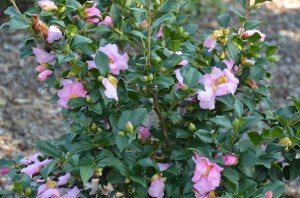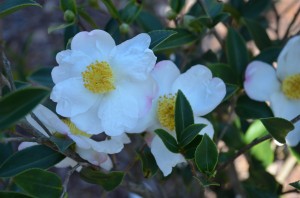Three Zone 6 winter hardy camellias are becoming more available. A recent visit to a local camellia grower found these three fall bloomers: ‘Long Island Pink’, ‘Londontowne Blush’, and ‘Sweet October’ in full floral regalia. The first two are reliably hardy in USDA zone 6 and a third nearly so.
‘Long Island Pink’ was found growing in Long Island, NY. It produces bright pink single flowers and glossy evergreen foliage. Long Island Pink is a handsome 10 feet by 8 feet shrub, with a slightly upright habit. Flower color is medium pink.
‘Londontowne Blush’ bears semi-double pale pink flowers in mid-fall. This cold hardy C. sasanqua hybrid comes from Dr. William Ackerman, the camellia breeder who earlier introduced the ‘Winter” camellia series. It bears single to semi-double pale pink flowers with deeply notched petals. A 10-year old plant grows 5-6 feet tall and almost as wide.
‘Sweet October’ is another Ackerman cross (C. oleifera x C. sasanqua). This mid-fall blooming camellia bears single white flowers with a splash of pink. It possesses a vigorous growth rate (10-12 feet tall and 8 feet wide after 8-10 years). It tends to be upright branched and flowers in mid-to late fall.
Note: Sweet October is rated zone 7-a hardy.
Camellia culture is similar to rhododendrons and azaleas. Plant them in a compost rich, acidic, well-drained garden soil. In their first growing season camellias should be moderately watered and fertilized to develop a deep fibrous root system. After two years camellias exhibit moderate drought tolerance because of their thick waxy foliage. Overwatering is a curse.
Feed with an acid-based fertilizer (such as Miracle-Gro® or Hollytone®) after bloom. Keep roots cool and moist with a 2-3 inch layer of mulch.
Camellias are generally pruned after flowering. An alternative is to prune all cultivars at one time in late April when all flowering has ended and before new spring growth has begun.
Planting camellias in front of evergreen shrubs and trees offers an excellent background as well as protects them from dry winter winds.



 Posted in
Posted in 
